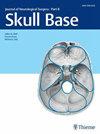CURRENT EVIDENCE IN THE MANAGEMENT OF CENTRAL SKULL BASE OSTEOMYELITIS- A SYSTEMATIC REVIEW
IF 0.9
4区 医学
Q3 Medicine
引用次数: 0
Abstract
Objectives: Based on current evidence, this systematic review focuses on various grey areas related to these patients' diagnosis, management and follow-up in central skull base osteomyelitis (CSBO). Study design: A systematic review of all case reports and observational studies. Methods: We systematically searched PubMed, Scopus database, Cochrane database, UK clinicaltrails.gov registry, and WHO ICTRP and included all reports as per our inclusion criteria. Data was analyzed systematically, and we made essential observations. Results: Out of 179 articles, 25 were selected according to inclusion criteria and quality assessment. Among the 44 patients, refractory headache (95%) was the most common presentation, followed by cranial nerve paralysis (82%) and Pseudomonas (32%) as the most common bacteria. Contrary to the available literature the disease cure was worse in those who underwent targeted biopsy (64% VS 36%, P = 0.023) and surgical debridement (61% vs 39%, P = 0.013) in the late stages of the disease. Conclusions: Otogenic osteomyelitis can spread to central skull bones in the absence of obvious ear symptoms. Early diagnosis and intervention of CSBO before progression to late stages can help decrease significant morbidity and mortality.治疗中枢性颅底骨髓炎的现有证据--系统回顾
研究目的基于现有证据,本系统性综述重点关注与中枢性颅底骨髓炎(CSBO)患者的诊断、管理和随访相关的各种灰色领域:研究设计:对所有病例报告和观察性研究进行系统综述:我们系统地检索了 PubMed、Scopus 数据库、Cochrane 数据库、英国 clinicaltrails.gov 注册表和世界卫生组织 ICTRP,并纳入了符合纳入标准的所有报告。我们对数据进行了系统分析,并提出了重要意见:结果:在 179 篇文章中,根据纳入标准和质量评估筛选出 25 篇。在 44 名患者中,最常见的表现是难治性头痛(95%),其次是颅神经麻痹(82%),最常见的细菌是假单胞菌(32%)。与现有文献相反,在疾病晚期接受靶向活检(64% VS 36%,P = 0.023)和手术清创(61% VS 39%,P = 0.013)的患者治愈率更高:结论:耳源性骨髓炎可在无明显耳部症状的情况下扩散至中央颅骨。结论:耳源性骨髓炎可在无明显耳部症状的情况下扩散至中央颅骨,在 CSBO 发展到晚期之前进行早期诊断和干预有助于降低显著的发病率和死亡率。
本文章由计算机程序翻译,如有差异,请以英文原文为准。
求助全文
约1分钟内获得全文
求助全文
来源期刊

Journal of Neurological Surgery Part B: Skull Base
CLINICAL NEUROLOGY-SURGERY
CiteScore
2.20
自引率
0.00%
发文量
516
期刊介绍:
The Journal of Neurological Surgery Part B: Skull Base (JNLS B) is a major publication from the world''s leading publisher in neurosurgery. JNLS B currently serves as the official organ of several national and international neurosurgery and skull base societies.
JNLS B is a peer-reviewed journal publishing original research, review articles, and technical notes covering all aspects of neurological surgery. The focus of JNLS B includes microsurgery as well as the latest minimally invasive techniques, such as stereotactic-guided surgery, endoscopy, and endovascular procedures. JNLS B is devoted to the techniques and procedures of skull base surgery.
 求助内容:
求助内容: 应助结果提醒方式:
应助结果提醒方式:


